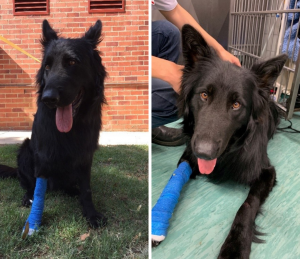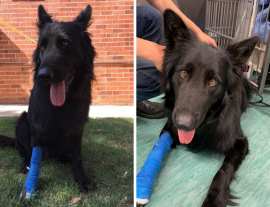 This is the handsome Jett, who came into Uni Vets Camden because the heatwave proved too much for him (especially with his thick, black fur)! Like humans, pets can suffer from heat stress when they’re exposed to extreme temperatures. However, unlike humans, dogs can’t produce sweat to cool their body down. While they can release some of their body heat from the nose, foot pads and by panting, these aren’t very effective when the temperature soars.
This is the handsome Jett, who came into Uni Vets Camden because the heatwave proved too much for him (especially with his thick, black fur)! Like humans, pets can suffer from heat stress when they’re exposed to extreme temperatures. However, unlike humans, dogs can’t produce sweat to cool their body down. While they can release some of their body heat from the nose, foot pads and by panting, these aren’t very effective when the temperature soars.
Luckily, after starting Jett on IV fluid therapy, oxygen therapy and copious amounts of cold wet towels, we were able to stabilise his body temperature and blood pressure! Here is Jett looking paw-sitively rejuvenated the next morning!
Keep your pet safe in summer by keeping them in the shade or indoors, exercising them in the morning/evening, providing plenty of fresh water, and never leaving them inside cars! If you notice your pet excessively panting, hypersalivating, weak or with an elevated heart rate, they may be showing early signs of heatstroke – in which case you should take them to the nearest vet!
By Anita Han, Final Year Veterinary Student, The University of Sydney
Assisted Chloe Ye
Bruchim, Y, Horowitz, M, & Aroch, I 2017, ‘Pathophysiology of heatstroke in dogs- revisited’, Temperature, vol 4, no. 4, pp. 356-370.
Romanucci, M, & Salda, LD 2013, ‘Pathophysiology and pathological findings of heatstroke in dogs’, Veterinary Medicine: Research and Reports, vol 4, pp. 1-9.






